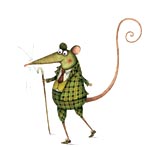Country mouse on a blackthorn winter
Mark sees the blackthorn blossom in the hedgerows


The blackthorn winter is upon us; flower-frosted branches of blossom adorn the hedgerows, painting the countryside in shrouds of snowy white. The blossom usually appears during a cold snap, hence the winter soubriquet, and the colder nights of recent days have triggered the flowering. A common hedging plant-its Latin name, Prunus spinosa, translates as spiny plum-disappears from our thoughts after the spring blossom disappears, but returns when the bitter-tasting, purple sloes appear in the autumn. The fruit grips to the branches long after its autumnal gold-and-crimson leaves have been shed.
As well as making excellent stockproof hedges, the wood can be made into the finest walking sticks, which were much admired for their natural polish by the Victorians. William Cobbett was a great fan of the tree and its sloes, ‘which have served love-song poets, in all ages, with a simile whereby to describe the eyes of their beauties'.
It was the traditional wood for Irish shillelaghs, a fierce cudgel secured to the wrist by a strap and described by the chairman of the Pharmacology Department at University of California, Los Angeles as ‘an ancient Hibernian tranquiliser'. The sloes, of course, can be added to gin, brandy or whisky to make excellent tipples for the hip flask.
* Subscribe to Country Life and save
* Follow Country Life magazine on Twitter
Sign up for the Country Life Newsletter
Exquisite houses, the beauty of Nature, and how to get the most from your life, straight to your inbox.
Country Life is unlike any other magazine: the only glossy weekly on the newsstand and the only magazine that has been guest-edited by HRH The King not once, but twice. It is a celebration of modern rural life and all its diverse joys and pleasures — that was first published in Queen Victoria's Diamond Jubilee year. Our eclectic mixture of witty and informative content — from the most up-to-date property news and commentary and a coveted glimpse inside some of the UK's best houses and gardens, to gardening, the arts and interior design, written by experts in their field — still cannot be found in print or online, anywhere else.
-
 380 acres and 90 bedrooms on the £25m private island being sold by one of Britain's top music producers
380 acres and 90 bedrooms on the £25m private island being sold by one of Britain's top music producersStormzy, Rihanna and the Rolling Stones are just a part of the story at Osea Island, a dot on the map in the seas off Essex.
By Lotte Brundle
-
 'A delicious chance to step back in time and bask in the best of Britain': An insider's guide to The Season
'A delicious chance to step back in time and bask in the best of Britain': An insider's guide to The SeasonHere's how to navigate this summer's top events in style, from those who know best.
By Madeleine Silver